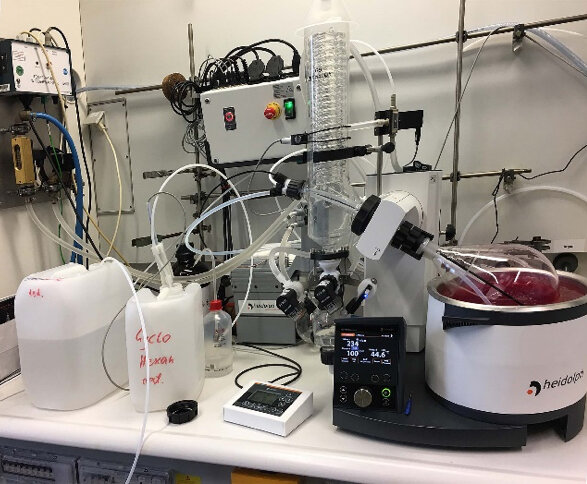Case Study
Augmentation du rendement grâce à l’automatisation
March 2022
- Hei-VAP
- Hei-VOLUME
- Automatisation
- Chimie
- Pharmacie
- Recyclage
- Solvants
- Évaporation
Dans certaines régions, la crise du coronavirus et l’augmentation des besoins en produits désinfectants (alcool isopropylique ou éthanol) qui en a résulté ont déjà provoqué des pénuries et une hausse du prix des solvants sur le marché mondial. Dans ce contexte, le recyclage des solvants est non seulement une activité durable, mais encore, une manière non négligeable de réduire les frais d’exploitation de votre laboratoire tout en augmentant son rendement.
En laboratoire, la récupération de solvants par un processus d’évaporation est une étape de travail courante, souvent réalisée à l’aide d’un évaporateur rotatif. Même si cet appareil de laboratoire est adapté au processus et ménage les échantillons, son fonctionnement manuel (dit par lots) n’est pas du tout rentable, en particulier pour purifier des quantités importantes de solvant.
Les ballons d'évaporation ont un volume limité et doivent être à nouveau remplis ou remplacés, ce qui entraîne des temps de chauffe longs du fluide froid avant le démarrage du processus. La capacité des ballons de récupération est également limitée et nécessite un vidage régulier pendant le fonctionnement. De plus, le système complet doit être aéré, ce qui oblige à stopper un processus en cours. L’évaporation en fonctionnement par lots est un processus dynamique lors duquel les conditions dans l’ensemble du système changent constamment. Ainsi, pendant son déroulement, le vide doit constamment être ajusté manuellement pour que les performances restent bonnes. Un(e) laborantin(e) passe donc plusieurs minutes à ajuster les paramètres du processus, à remplir et à vider les ballons ou, le cas échéant, à les remplacer. Ce facteur de coût réduit les économies possibles.
Plusieurs centaines de clients dans le monde ont pu considérablement augmenter la rentabilité du recyclage des solvants grâce à l’utilisation d’un module automatique, qui règle de manière autonome le remplissage et le vidage des ballons d'évaporation et de récupération. L’université de Bayreuth (Allemagne) est un exemple concret de cette augmentation de la rentabilité. Dans le domaine de la chimie macromoléculaire, de très petites quantités au contenu semblables étaient très souvent évaporées, ce qui est courant dans les laboratoires de chimie. Les doctorants et laborantins qui y travaillent passaient une partie non négligeable de leur temps à effectuer ces étapes de travail caractéristiques sur l’évaporateur rotatif pour purifier de petites quantités de quelques centaines de millilitres.
Monsieur Lothar Benker, responsable du pool d’appareils pour ce groupe de travail, a reconnu le potentiel d’une automatisation et donné pour instruction aux doctorants de collecter les petites quantités dans des récipients de 5 à 20 litres, et de ne plus consacrer de temps au traitement manuel. Dans la nouvelle procédure, à la fin de la journée de travail le système Heidolph, composé du module automatique Distimatic et de l’évaporateur rotatif (Fig. 1), est mis en route et, pendant la nuit, l’un des récipients remplis durant la journée est traité automatiquement sans surveillance. Le lendemain matin, les doctorants trouvent les liquides séparés, qui sont alors directement disponibles et prêts à être utilisés dans le laboratoire. Monsieur Benker estime le temps gagné par ses doctorants, qui peut désormais être consacré à la recherche, à plus d’une heure par jour et par personne.
The COVID-19 crisis and the resulting increased demand for disinfectants such as isopropanol or ethanol have already led to bottlenecks in some regions and to a rise in solvents prices on the world market. Therefore, solvent recycling is not only a sustainable but also a considerable way of reducing operating costs in the own laboratory and at the same time increasing efficiency.
Solvent recovery by means of an evaporation process is a common laboratory work process, for which often a rotary evaporator is used. Even if this is a suitable and sample-conserving lab device for this process, the manual operation (the so-called batch operation) is less than efficient, in particular, if larger solvent volumes have to be purified.
Evaporating flasks only hold a limited volume and must be refilled or replaced, which leads to long heating times of the cold medium before the process starts again. The capacity of receiving flasks is also limited and requires regular emptying during operation. To do this, the entire system must be ventilated and a running process must be stopped. Evaporation in batch operation is a dynamic process during which the conditions in the entire system are constantly changing. In addition, the vacuum has to be manually readjusted several times in order to achieve a consistently high performance. Consequently, a laboratory employee is often busy for several minutes adjusting the process parameters, filling and emptying the flasks or changing them if necessary. This is a cost factor that reduces the possible savings.
Hundreds of customers worldwide have already achieved a significant efficiency increase in solvent recycling by using an automated module that independently controls the filling and emptying of the evaporator and receiving flasks. The University of Bayreuth (Germany) provides us with a concrete example for this increase in efficiency. At the labs of the Faculty of Macromolecular Chemistry, very small quantities with similar contents were very often evaporated, as usual in chemistry laboratories. The doctoral students and laboratory assistants working in this laboratory spent a significant amount of time performing the typical work steps on the rotary evaporator in order to purify small amounts of a few hundred milliliters of solvents.
Mr. Lothar Benker, responsible for the equipment pool in this work group, recognized the potential of automation and instructed the doctoral students in the respective work group to collect the small quantities into 5 to 20-liter containers and not to bother with manual processing. The new workflow established is designed in such manner that at the end of the working day, the Heidolph system of the Distimatic automatic module and rotary evaporator (Fig. 1) is switched on and one of the containers filled during the day is automatically processed overnight without supervision. The next morning, the doctoral students find the separated liquids ready for use, which are then immediately available for further use in the laboratory. Mr. Benker estimates that now, his doctoral students have an additional hour for research per day per employee.


